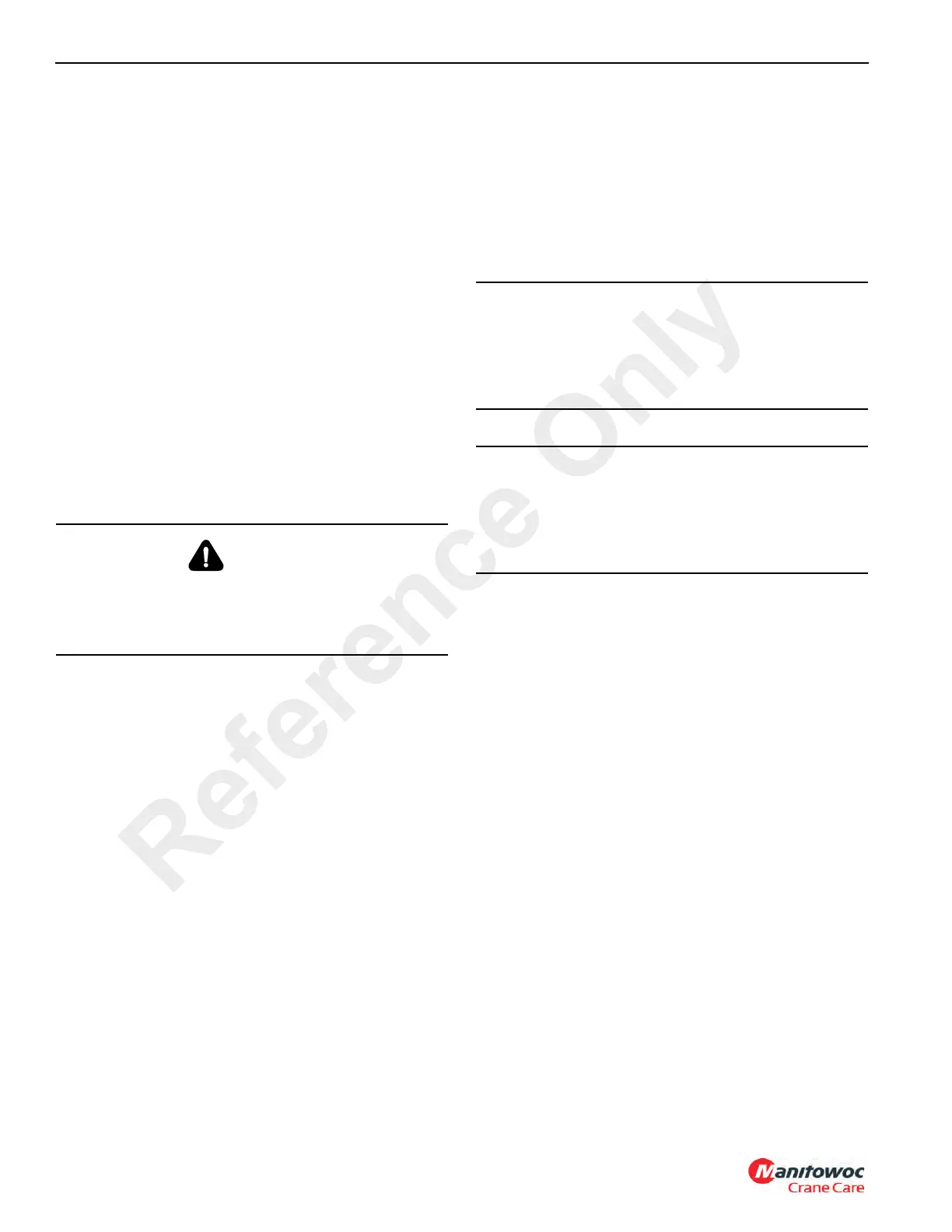UNDERCARRIAGE RT540E SERVICE MANUAL
8-34 Published 4-20-2015, Control # 502-01
6. Tag and disconnect the hydraulic lines at the cylinder
barrel end of the extension cylinder. Cap all lines and
fittings.
NOTE: Do not allow the end of the outrigger extension
cylinder to fall when the cylinder mounting shaft is
removed. Use blocking to limit the drop or an
adequate soft support to cushion any distance the
rod will drop.
7. Remove the cotter pin and clevis pin securing the
cylinder barrel end of the extension cylinder to the
outrigger housing. Carefully extend the outrigger beam
until the extension cylinder is free of the housing and
carefully lay the end of the cylinder on the bottom of the
outrigger beam or leave on blocking.
8. After attaching a suitable lifting device of straps or belts
(Figure 8-31) instead of chains to prevent nicking the
bottom edges of the outrigger beam, pull the outrigger
beam out of the outrigger box, re-adjusting the lifting
attachment to prevent the extension cylinder from sliding
out of the outrigger beam when the beam clears the
outrigger box.
NOTE: The outrigger beam assembly weighs
approximately 374 kg (824 lb).
9. Position the outrigger beam on the blocking material.
Inspection
Inspect the outrigger beams for bends, evidence of cracks,
or other damage. Check the outrigger beam internally for
hydraulic fluid, which may indicate a leaking cylinder, loose
connection, or damaged hydraulic line.
Installation
NOTE: Apply anti-seeze compound on clevis pins and
setscrews during installation.
1. Apply grease (EPMPG) to the bottom of the outrigger
beam.
2. If removed, install the side adjustable wear pad in the
outrigger beam.
3. Install the bottom wear pads with approximately 6 mm
(0.23 in) protruding. This will prevent the beam side
plates from riding on the bottom of the box (Figure 8-32).
4. Attach a suitable lifting device of straps or belts instead
of chains to prevent nicking the bottom edges of the
outrigger beam.
5. Slide the beam into the outrigger housing and align the
cylinder bushing with the mounting hole.
6. Apply anti-seeze compound to the clevis pin. Secure the
cylinder barrel to the housing with the clevis pin and
cotter pin.
7. Connect the hydraulic lines as tagged prior to removal.
8. Install the side adjustable wear pad in the outrigger box.
9. Adjust the wear pads, refer to WEAR PAD
ADJUSTMENT in this Sub-Section.
10. Install the end cover.
NOTE: At installation, be sure that the outrigger jack
cylinder hydraulic hoses are not trapped against
the outrigger box when the beam is fully retracted.
Wear Pad Adjustment.
NOTE: When adjusting wear pads, refer to Wear Pad
Adjustment (Figure 8-32).
1. Adjust the bottom wear pads until a gap of 3 mm
(0.11 in) is obtained between the top of the beam and
the top of the outrigger box. Install and lock setscrew
against wear pad.
2. Adjust outrigger box side wear pad until a gap of 2 mm
(0.07 in) is obtained between beam and shims welded in
top and bottom of box. Install and lock set screw against
wear pad.
3. Adjust outrigger beam side wear pad until a gap of 2 mm
(0.07 in) is obtained between shim welded on beam and
side of box. Install and lock set screw against wear pad.
DANGER
Be sure any blocking material used is capable of
supporting the weight of the outrigger beam. Do not allow
it to tilt or slide. Failure to do so could result in death or
injury to personnel.
CAUTION
Be sure that the piston side of all outrigger cylinders are
connected to the solenoid valve bank. Reversal of port
connection of the rod and piston sides could result in
severe damage to the cylinders as very high pressure
intensification will occur.
CAUTION
During initial start-up and checking of the outrigger
operation, each control switch must be operated before
operating the selector valve. If hydraulic lines are
reversed to one or more cylinders, this will prevent
damage to the cylinders.
Reference Only
